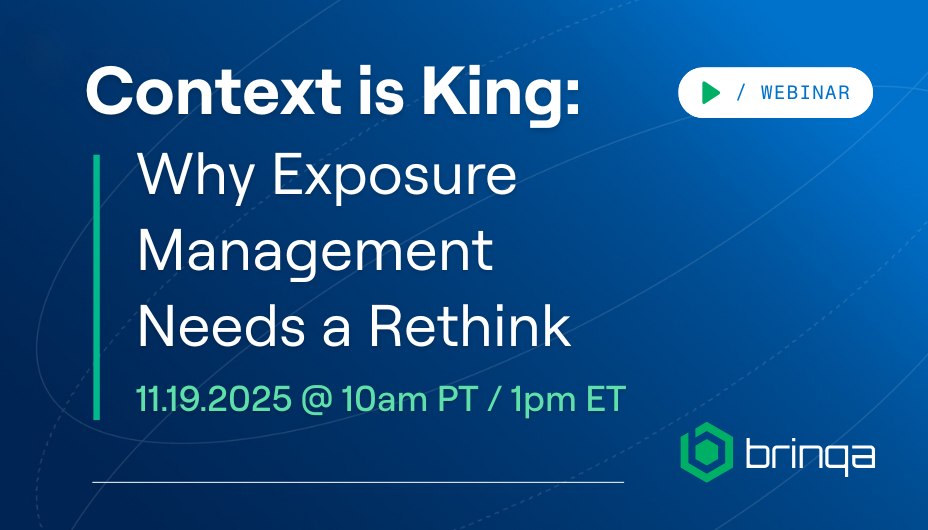Context Creates Clarity: How a Healthcare Organization Improved Application and Cloud Risk Visibility
by James Walta, VP Customer Success//6 min read/

Stories from the Field is a monthly series sharing real-world lessons from security leaders who’ve tackled challenges in vulnerability and risk exposure management – turning obstacles into opportunities for stronger, data-driven security programs.
In this story, a large healthcare organization improved application and cloud risk visibility by connecting data across serverless, container, and traditional systems. By analyzing historical vulnerabilities and software end-of-support risks, the security team gained context that helped them prioritize remediation, reduce uncertainty, and strengthen decision-making.
The Challenge: Achieving True Application and Cloud Risk Visibility
For many healthcare organizations, managing application and cloud risk has become increasingly complex. New workloads appear every day, vulnerabilities evolve faster than teams can address them, and maintaining consistent visibility across diverse systems is a constant effort.
At this organization, the security operations team was responsible for hundreds of critical applications spread across a hybrid environment of cloud workloads, containers, and serverless architectures. Their tools generated plenty of data, but it existed in silos. Reports highlighted individual vulnerabilities without showing how they related to one another or how long they had been present. Some serverless workloads weren’t captured at all, and historical data lacked the depth to reveal patterns or aging trends. As a result, risk grades reflected only what was vulnerable in the moment, without considering software approaching end of support or issues that had quietly persisted over time.
The team had visibility, but not clarity. They could see the data, but they couldn’t see the story behind it. They needed a more connected view that revealed which risks truly mattered to the business.
The Approach: Building Context Across Systems and Data
To strengthen understanding of their application and cloud risk, the organization expanded its reporting model to connect data from multiple systems.
The team developed a new application report that incorporated previously unseen workloads into view. This addition allowed them to see risk across serverless environments alongside container and traditional infrastructure.
They also revisited how historical data was calculated. By refining “first-found” dates, the team could identify vulnerabilities that had existed for extended periods. This provided valuable insight into which risks were recurring or consistently overlooked, improving their ability to prioritize remediation.
Finally, they enhanced their container grading model to include both container and image violations, as well as software end-of-support timelines. This revealed emerging risks tied to outdated or unsupported components.
Together, these steps transformed fragmented data into a unified view of exposure, providing context that made their visibility meaningful.
The Results: Contextual Insight that Drives Confidence
The result was a comprehensive application and cloud risk report that delivered an accurate and actionable view of exposure across the organization’s technology ecosystem.
With this model, the team could identify which applications carried the highest exposure, which vulnerabilities had persisted the longest, and which systems were nearing end-of-support. Leadership gained confidence that reports reflected a true picture of risk.
Remediation became more strategic; teams aligned on priorities, resources were used more effectively, and long-standing vulnerabilities decreased. Instead of reacting to every new finding, the organization could anticipate what was coming next. Security decisions became proactive rather than reactive.
It wasn’t just a better data, it was a better understanding.
The Lesson: Why Context Is Central to Exposure Management
This story shows that progress in cybersecurity doesn’t always come from new tools. Sometimes it comes from connecting the data that already exists and making it meaningful.
By expanding visibility and interpreting data in context, the team built a model for continuous understanding – one that reflected not just what was vulnerable, but what was at risk. That continuous understanding is the foundation of effective exposure management, where teams align visibility, prioritization, and action.
In complex application and cloud environments, that kind of clarity is the foundation of confidence. It’s what allows organizations to act sooner, communicate better, and manage exposure with purpose.
Brinqa Insight
True exposure management requires more than visibility. It requires connected data, continuous context, and the confidence to act early. Organizations that unify their information across applications, containers, and cloud environments can reduce uncertainty, strengthen resilience, and make smarter security decisions in an imperfect world.
Because you can’t manage exposure in a perfect world, Brinqa built a platform for the imperfect one. Meet with one of our Brinqa Experts to see our data-driven exposure platform in action.
Up Next:



